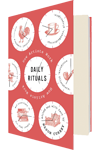For a while now, conventional wisdom has been throwing cold water on the idea of artistic genius. Forget the Shakespeare who “never blotted a line” and the Keats who wanted poems to come as naturally “as leaves to a tree.” If you want to achieve something great, tack to your mirror that Edison quotation about 99 percent perspiration and 1 percent inspiration; ponder Malcolm Gladwell’s summary of the ten-thousand-hour rule. Mason Currey’s Daily Rituals, a collection of short biographical descriptions of artists’ routines, seems right in step with this trend. It wants to offer a compendium of evidence for the effort-trumps-all theory in creativity studies: “Work work work,” Currey says by way of summarizing his project. This could mark the moment at which art, too, joins our current productivity-mad culture: if you like the Pomodoro Technique and the Fitbit, try the Trollope (he set his watch to write 250 words every fifteen minutes) or the Hemingway (he entered his daily word count on a wall chart). Learn the artistic version of Getting Things Done.
Or, rather, learn how art upends that idea. The accumulation of examples in Daily Rituals, in fact, shows how often artists resist the driven directive to “work work work.” The schedules described are regular, sure, but they’re almost always limited. Most of the artists settle on a timetable that is consistent but abbreviated, with no more than four consecutive hours of creative activity. Some prefer a single stretch, like Thomas Mann’s morning; some, like Simone de Beauvoir, fit in two sessions around a long lunch. Those who spend more time in the office might keep “business hours” but write “for only a small portion of that time”—two hours, in Martin Amis’s case. The maximum, according to Chuck Close, is “three hours in the morning and three hours in the afternoon.” To try for more might be not just difficult but also outright harmful. Ask Descartes, who counted indolence as necessary and “made sure not to overexert himself.” The most prolific figures in the book are not those who worked the longest: Georges Simenon, who published over four hundred books, wrote for only a few hours a day.
This means that writers who took other jobs to pay the bills—Kafka at an insurance office, Orwell at a bookstore—aren’t at much of a disadvantage. An artist’s schedule is important, Currey’s book reminds us, for its refusal to squeeze the most working minutes out of the artist’s waking hours. At a moment when we’re working longer than ever—and, as we dutifully lean in, trying to feel inspired and empowered by working more—it’s useful to recall that many of the greatest minds planned to fritter away parts of their days, that their routines protected creativity by filling the time around a more or less fixed window of possible, genuine intensity. Some strategies are more whimsical, like Patricia Highsmith’s habit of tending snails or Flannery O’Connor’s of raising birds, but most are very ordinary: Stephen King watching baseball, Jean Stafford gardening. There’s a good bit of smoking in this book, and a steady attention to drinking; there’s a lot of walking, too. (It seems to work even if you don’t, like Tchaikovsky, panic at any stroll shorter than two hours.) But one suspects that smoking and drinking and walking are so popular because they are the most universally accessible way to stave off the restlessness of the hours when one cannot—should not—be at a desk. They offer a way to forget how brief and chancy is the ability to create something new, to refine something beautiful, to think something true.
And about that ability, of course, schedules can say very little. That’s another point to be taken from this fascinating compendium. As if to recognize the mystery, Currey’s title evolved, when he turned his blog into this book, from Daily Routines to Daily Rituals. The amendment sneaks something spiritual back into his obsession with habit. Like the rites of religious devotion, the timetables of art surround an essence that is unrepeatable and unquantifiable. “It will appear like a calm existence,” Maira Kalman says of her schedule, but “the turmoil is invisible.” We fetishize that trackable calm because we cannot reproduce the inexplicable turmoil.
So it’s worth remembering that Balanchine was no more able to choreograph Agon because he played solitaire in the morning than Schubert was able to compose the Trout Quintet because he read newspapers in the afternoon or Hobbes able to theorize the social contract because he sang popular tunes in the evenings. If we resist a cause-and-effect logic in our obsession with artistic routines, we can remember that good ideas or great art are the unpredictable outcomes of a predictable regimen—they are, by their very definition, out of the ordinary.
—Siobhan Phillips





